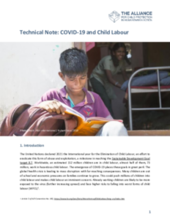Displaying 41 - 50 of 337
This child-led research initiative was conducted under the umbrella of World Vision’s DEAR project (Development Education and Awareness Raising) and the Sustainable Development Agenda 2030. The study explores explore SDG 16.2, the goal that focuses on the issue of ‘abuse, exploitation, trafficking, and all forms of violence against and torture of children’.
This technical note offers guidance and information to practitioners and policy-makers on child labour issues during and after COVID-19 and what actions can be taken.
This animated video from Alternative Care Thailand tells the story of a boy in Thailand who is sent to live in an orphanage because his mother feels she is unable to care for him at home, his experiences with volunteers once he arrives at the orphanage, and how the orphanage transitioned to supporting children to live in families.
This article traces the evolution of the recognition of orphanage trafficking broadly, and then focusses on recommendations made by the Australian government following the release of its 2017 Hidden in Plain Sight Report.
This article explores the perspectives of Cambodian boys who have experienced human trafficking and sexual exploitation on their experiences transitioning out of shelters and re‐entering the community.
The purpose of this study was to describe the demographics, state-dependent living situations, and juvenile detention usage of state-dependent commercially sexually exploited youth.
This Country Care Review includes the care-related concluding observations adopted by the Committee on the Rights of the Child and the Committee on the Rights of Persons with Disabilities, as well as other care-related concluding observations, ratification dates, and links to the Universal Periodic Review and Hague Intercountry Adoption Country Profile.
This briefing paper has been compiled using information included in the Out of the Shadows Index - which measures a country’s response to child sexual exploitation and abuse - and the ECPAT Country Overview for Nepal. The brief highlights the risk of sexual exploitation resulting from voluntourism practices, including volunteering in or visiting orphanages.
This column from Volume 23 of the American University Washington College of Law Human Rights Brief explores the links between child abuse in Cambodian orphanages and tourism.
This report delves into the differences between boys’ and girls’ experiences through a gendered analysis of the six grave violations of children in conflict, including recruitment of children by armed forces and child abduction. The report makes reference to the vulnerabilities faced by girl heads of household or unaccompanied and separated girls on the move and calls for interventions such as family tracing and reunification, the provision of alternative care for unaccompanied and separated children, and the release and reintegration of children associated with armed forces and armed groups.







